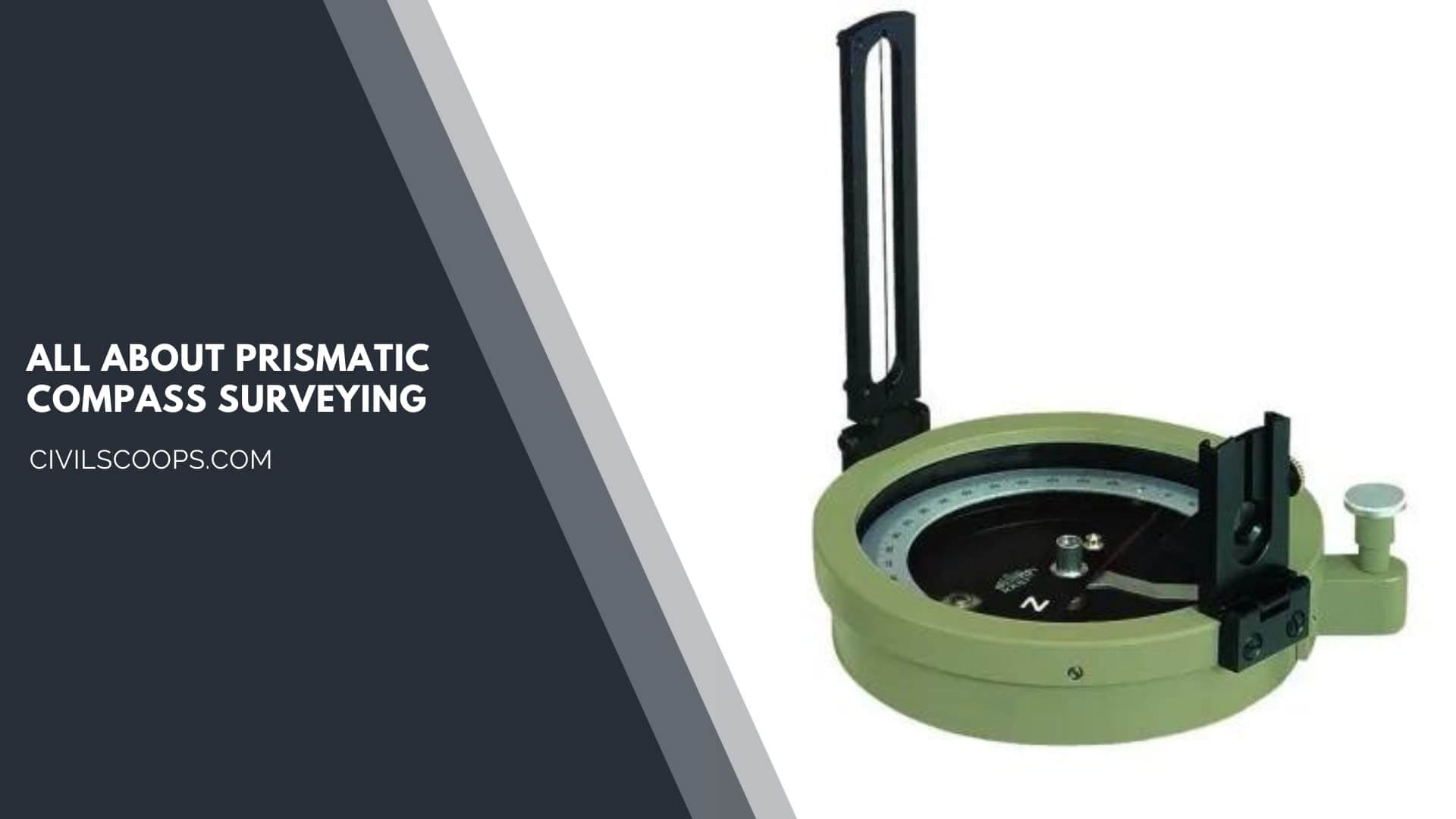
Table of Contents
What Is Prismatic Compass Surveying?
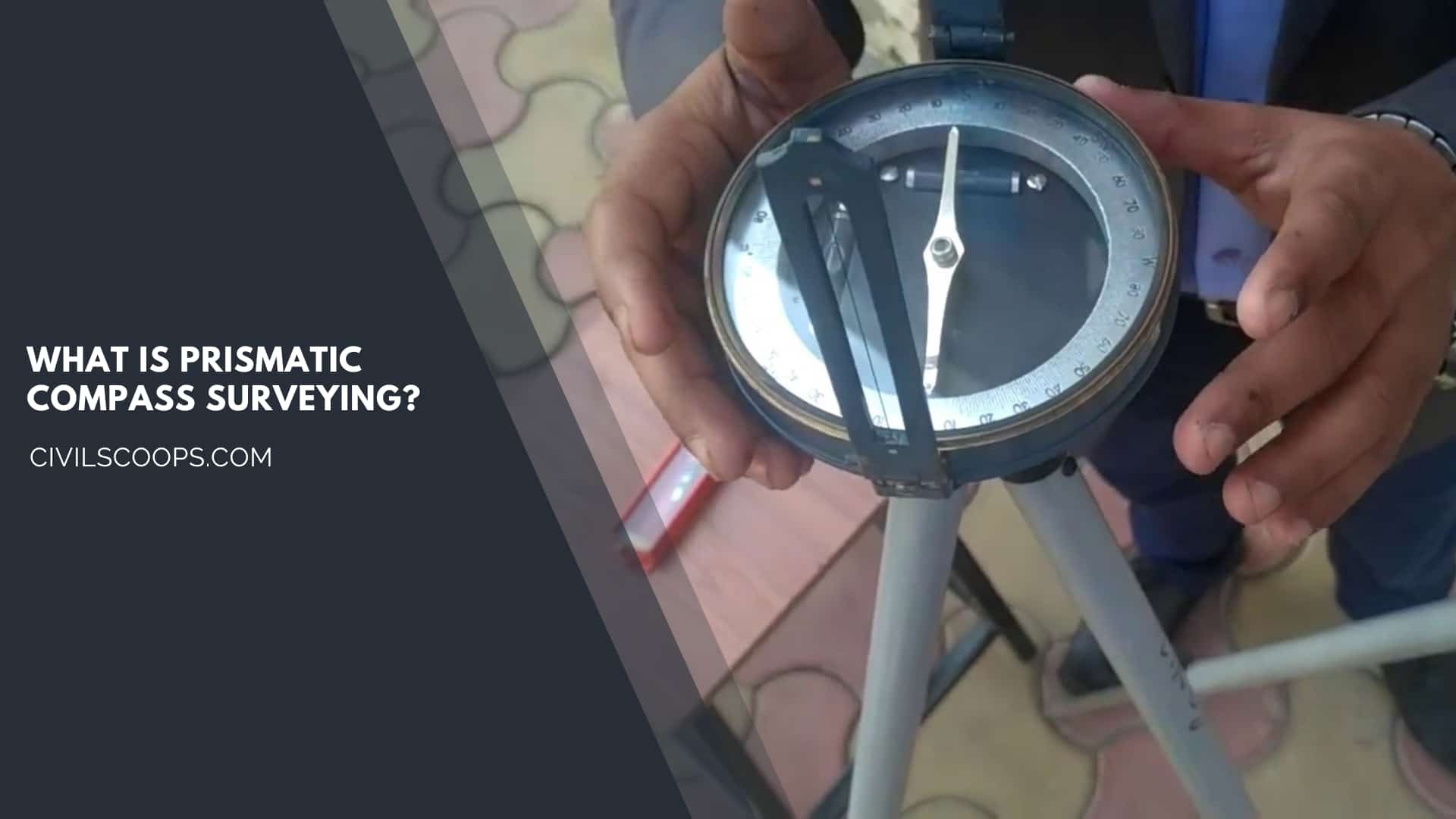
What is prismatic compass surveying? It is the kind of prismatic compass survey used only to determine the angles identified as bearing as well as the range is determined by the measuring tape.
Often referred to as a prism compass, it’s essential for various surveying tasks.
Prismatic compass is compact and flexible, normally borne by hand.
This prismatic compass is among the two major types of magnetic compasses used in the series for the function of magnetic bearing measurement, the exception being the magnetic compass.
The circle is read as observing the conclusion of the graduation run clockwise from the south end of the needle.
The mirror located in front of the forward vane slides up and down the vane, folding flat over it, or resting inclined at any angle with it.
This mirror is used to see single objects or to view some very high object and is normally fitted to a compass.
The prismatic adapter consists of a 45-degree translucent prism with ice and a strongly convex reading mask to magnify the image of the graduation.
The prism is installed and can be rotated up and down between both the slides around the outside of the case.
The goal of this up and down movement is to have a concentration change.
The graduation image is seen through a small circular aperture in the prism mounting and immediately above this aperture is a small v cut on top of the mounting over which the vertical wire in the front aperture can be viewed.
The prismatic compass is mostly found in a compact instrument which would be kept in the hand for observation and is thus used in rougher working groups.
The graduated upon that prismatic compass is located on a lightweight aluminum ring affixed to the needle, as well as the graduation zero corresponds with the graduation point only at the south of the needle, which means that the needle stays stationary as well as the index is rotated with the sighting valves.
Also Read: Earthmoving Equipment With Picture
Parts of Prismatic Compass
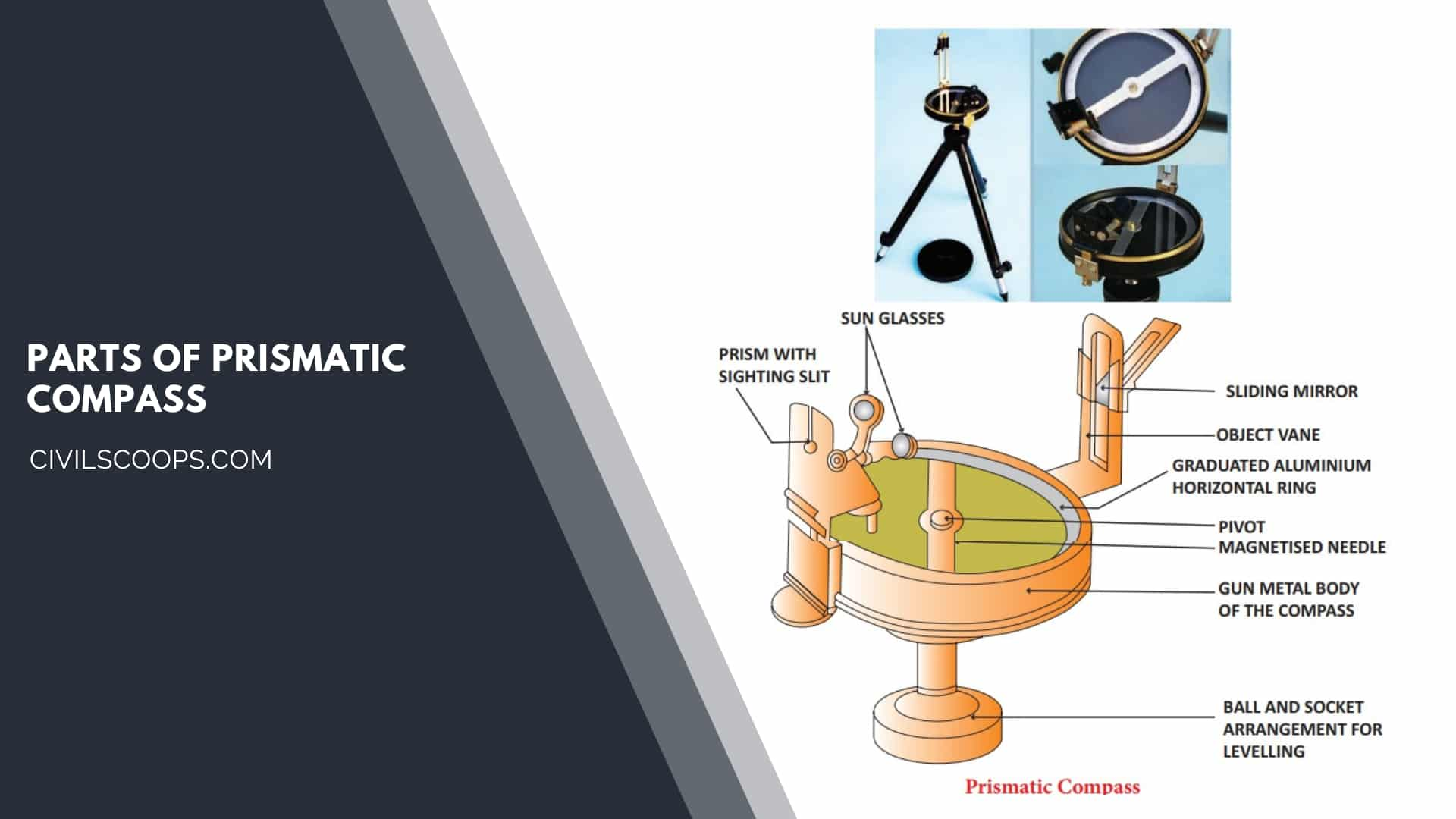
- Cylindrical Metal Box: The cylindrical box, often depicted in a prismatic compass diagram, with a size of 8 to 12 cm covers the compass and then the whole casting or body of the compass. This is one of the key prismatic compass parts.
- Eye Valve: The eye valve is fine silt with an eye hole in the bottom to bend the object out of the silt.
- Cover of Glass: It fills the instrument box from the top so that the needle as well as the graduated ring can be seen from top.
- Graduation Circle: This is an aluminum graduated ring labeled of 0° to 360° to calculate all potential line bearings and connected with a magnetic needle.
- Lifting Pin and Lifting Lever: Below the viewing vane. Lift pin pressed while the sight vane is folded. The magnetic needle was raised from the pivot point with the aid of the lever raise.
- Prism: Prism is being used to recognize the graduation on the ring and also to read the same reading by compass. It’s positioned in the opposite direction of the object vane. The prism hole is covered by a prism cap to shield it from dust and moisture.
- Spring Break: In order to dampen the vibration of the needle once obtaining a measurement to putting it to resting easily, the light spring break connected to the box comes into contact only with a knob of the ring by softly squeezing the brake pin word.
- Object Vane: The vane of the object is diametrically opposed to the prism and eye valves. The object vane holding horsehair or black thin wire to see the object in line with the sight of the object.
- Sunglasses: Used whenever some luminous objects have to be bisected. Mounted in front of the eye slit and also in a batch of 3 or 4 shades of various colors to give a sharp image of the artifacts.
- Reflecting Mirror: Often used to obtain a picture of an object positioned higher or lower surface of the device when bisecting. Located directly opposite to the vane object. The prism hole is sealed by a prism cap to secure it against dust including moisture. Mounted mostly on the vane of the subject.
- Pivot: The pivot is offered at the middle of the compass which supports a loosely attached magnetic needle.
- Magnetic Needle: The magnetic needle is the core of the device. That needle determines the angle of the line from either the magnetic meridian since the needle is often pointing to the north-south pole at the opposite edges of the needle while freely placed on some support.
Useful Article for You
- What Is a Highway Flyover
- What Is Grouting
- What Is a Pile Cap
- What Is a Bond Beam in Masonry
- What Is Sapwood
- What Is Crane
- What Is a Gable
- What Is Superelevation
- What Is Kerb
- What Is the Purpose of Washers
- What Is the Size of a Brick in Inches
- What Is Reinforced Masonry
- What Is Workability
- What Is Bond Breaker
- What Is Plasticizer in Concrete
- What Is Luminous Flux Vs Lumens
- What Is Caisson
- What Is an Undercoat
- What Is a Benchmark Surveying
- What Is Bracing in Construction
- What Is a Beam in Construction
- What Is the Standard Door Frame Size
- What Is a Spandrel Beam
- What Is a Fire Escape
- What Is a Weep Hole
- What Is Tie Beam
- What Is Fine Aggregate
- What Is Pony Wall
- What Is Flag Stone
- What Is Development Length
- What Is Cement Plaster
- What Is a Pitched Roof
- What Is Rafters
- What Is a Slab in Construction
- What Is a Monolithic Slab
- What Is Linear Distance
- What Is Shovel
- What Is Lintel in Construction
- What Is a Concept Sketch
- What Is Mezzanine Floor
- What Is Man Sand
- What Is Plaster Made Out of
- What Is a Floating Slab
- What Is Falsework
- What Is Bituminous
- What Is a Spillway
- What Is Curb and Gutter
- What Is Dampness
- What Is Lap Length
- What Is the Full Form of Fsi
- What Is Door Frame
Uses of Prismatic Compass

- The use of prismatic compass, especially in liquid form, can always be used separately or in combination with other angle-measuring instruments in the orientation of a chart or a plane table and in the prismatic compass in surveying or traversing process.
- Prismatic compass is Commonly used for rough surveys where the key concern is speed and not precision.
- Geologists and surveyors are commonly used to make precise measurements of degree and angle.
- A prismatic compass is an instrument used to calculate the bearing of a magnetic meridian.
Also Read: What Is Superstructures | Difference Between Load-Bearing and Framed Structures
Advantages of Prismatic Compass
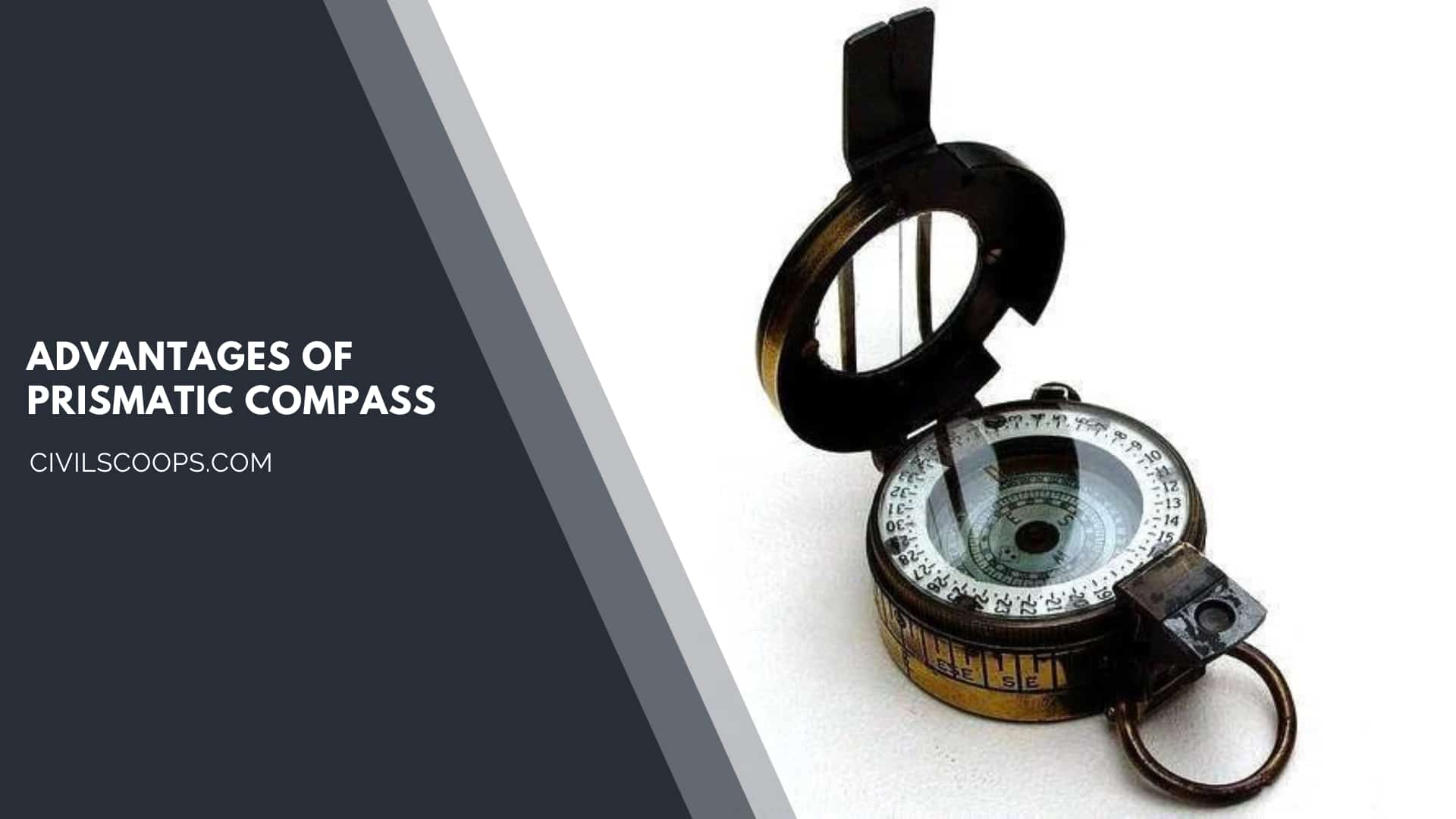
- Viewing the object and also understanding the circle can be achieved concurrently without shifting the location of the eye.
- The circle is interpreted at the reading where the hairline seems to be sliced.
- They’re lightweight and compact.
- They have fewer settings to repair it on a station.
- The error made in a single survey doesn’t really impact other lines.
- It is necessary to retrace surveys.
Disadvantages of Prismatic Compass
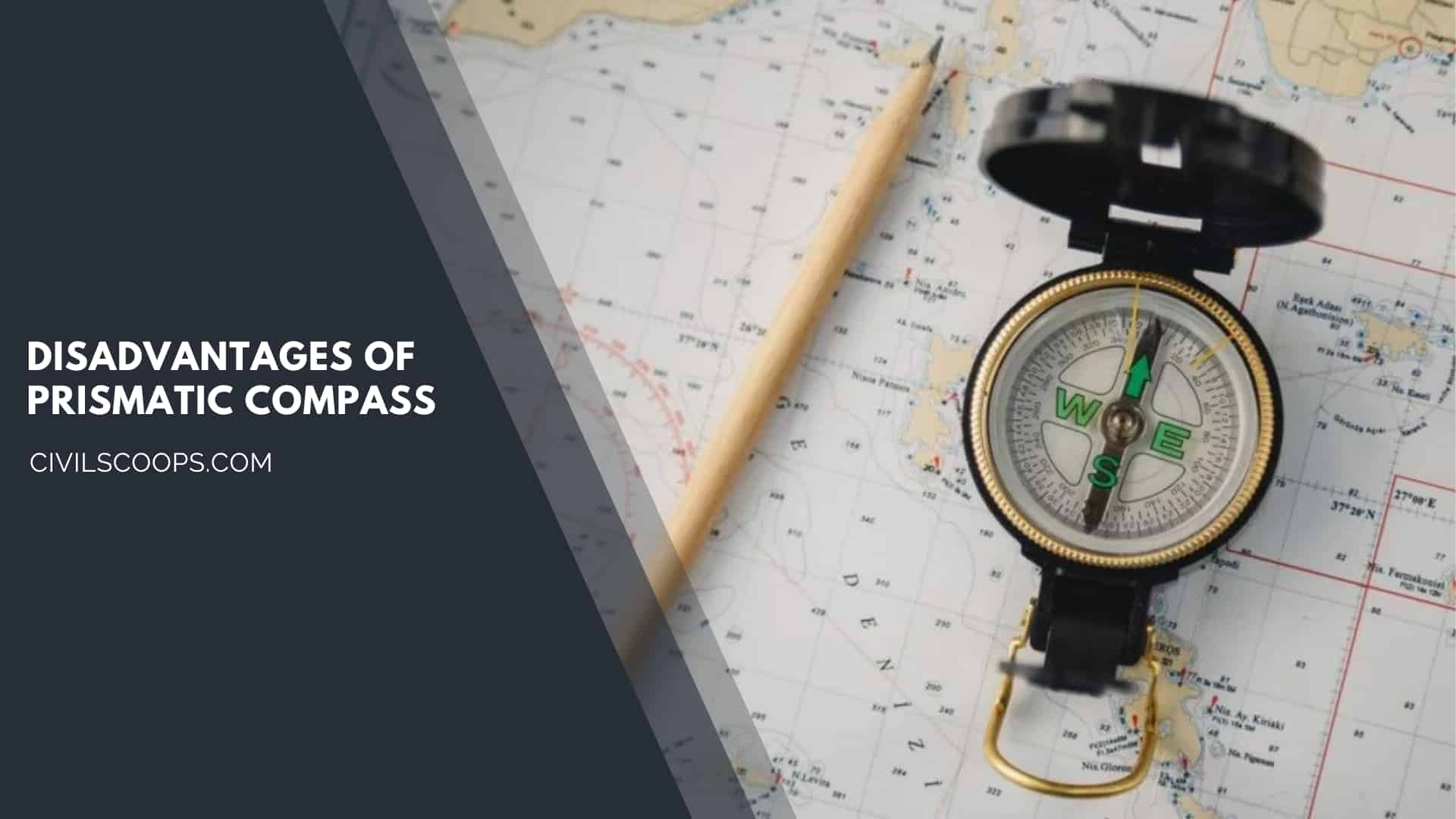
- Cannot be performed in environments considered to have magnetic content.
- Demand expertise, especially about rocks, to recognize the presence of iron ore.
- It is difficult to keep the compass perfectly still while taking the bearing, so it is hard to totally avoid errors.
- Prismatic compass surveying is not useful for long distances.
Useful Article for You
- How Wide Is a Cinder Block
- How Much Is a Coffered Ceiling
- How to Make Mortar
- How Long Does Hempcrete Last
- How to Use a Hand Sight Level
- How to Construction
- How to Build a Lean to Roof
- How Are Tunnels Built
- How to Layout a Building
- How Wide Is a Car Parking Space
- How Do Shear Walls Work
- How to Measure Concrete Slump
- How Are Bridge Foundations Built
- How to Use Washers with Screws
- How Dense Is Sand
- How High Is a Window from the Floor
- How to Fix Spalling Concrete Foundation
- How Does a Beam Bridge Work
- How Do They Pour Concrete Under Water
- How Does a Sewer System Work
- How High Are Countertops
- How to Seal Brick Wall Interior
- How to Resurface Cement
- How to Use Portland Cement
- How Is Plaster Made
- How to Find Fineness Modulus
- How to Get Rid of Spray Paint Smell on Metal
- How Many Types of Slope Are There
- How Big Is a Stair Landing
- How Does Rebar Help Concrete
- How to Identify a Load Bearing Wall
- How to Get Paint Off Concrete Without Chemicals
- How to Fix Water Damaged Drywall
- How Much to Get Septic Pumped
- How to Cut a Nail or Screw
- How Long Does Wet Concrete Take to Dry
- How Is Varnish Made
- How Does Ejector Pump Work
- How Does a Cantilever Bridge Work
- How Does Hydrometer Work
- How to Get Wet Blood Out of Carpet
- How to Build House on Slope
- How Thick Is Plaster Wall
- How Suspension Bridges Work
- How to Seal a Concrete Roof
- How Was Cement Invented
- How to Calculate Area of Steel
- How to Check Silt Content in Sand
- How a Building Is Constructed
- How Are Roads Classified in India
Applications of Prismatic Compass
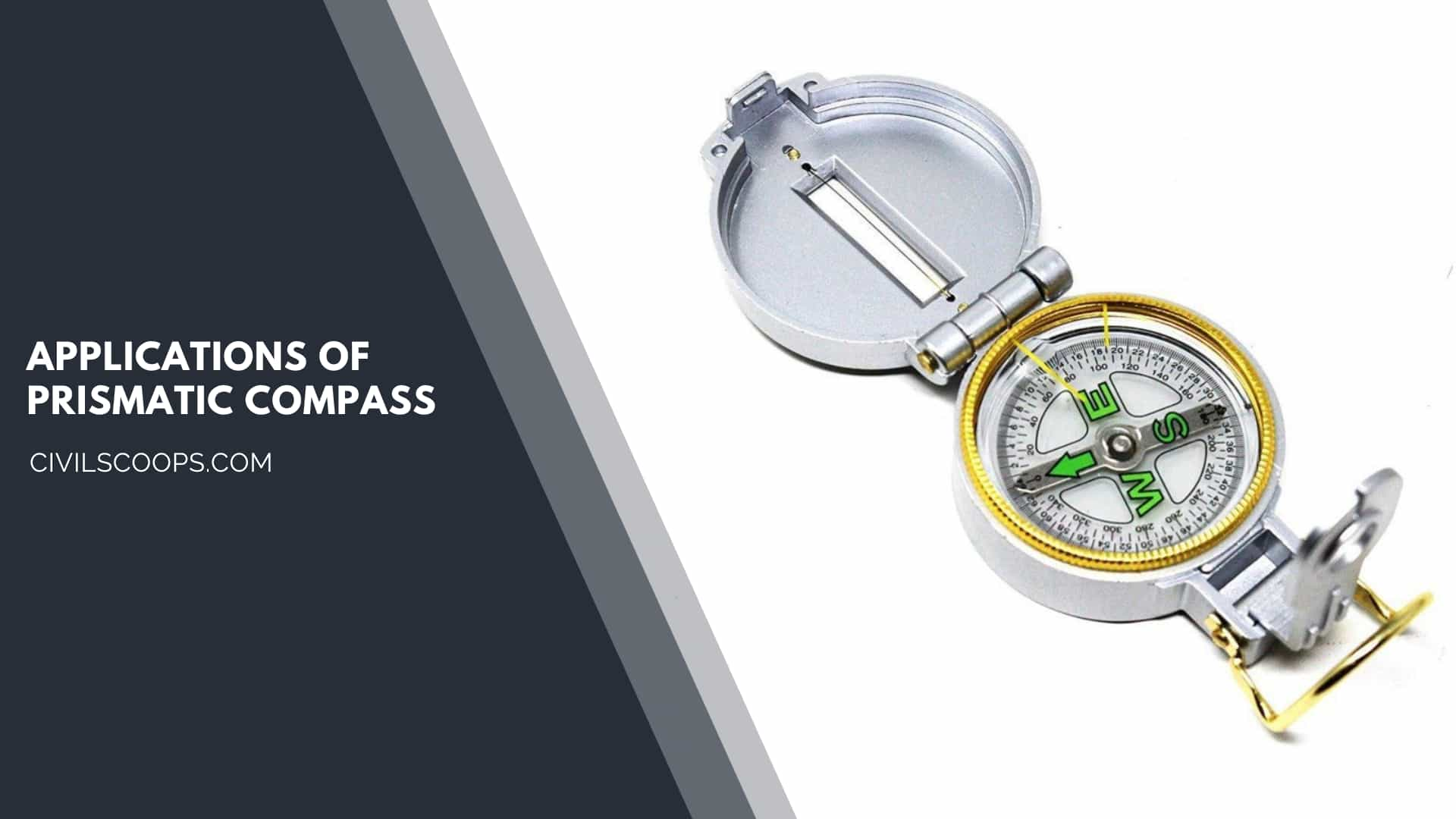
- Such a mirror can be used for solar analysis or for observing some very high object and is not a standard compass fitting.
- The two circular discs at the front of the back of the vane are darkened glasses that can be swing at the front of the vane whenever solar observation is completed.
Also Read: Understanding Oblique Drawing: Techniques, Examples, and Applications
Method of Using a Prismatic Compass
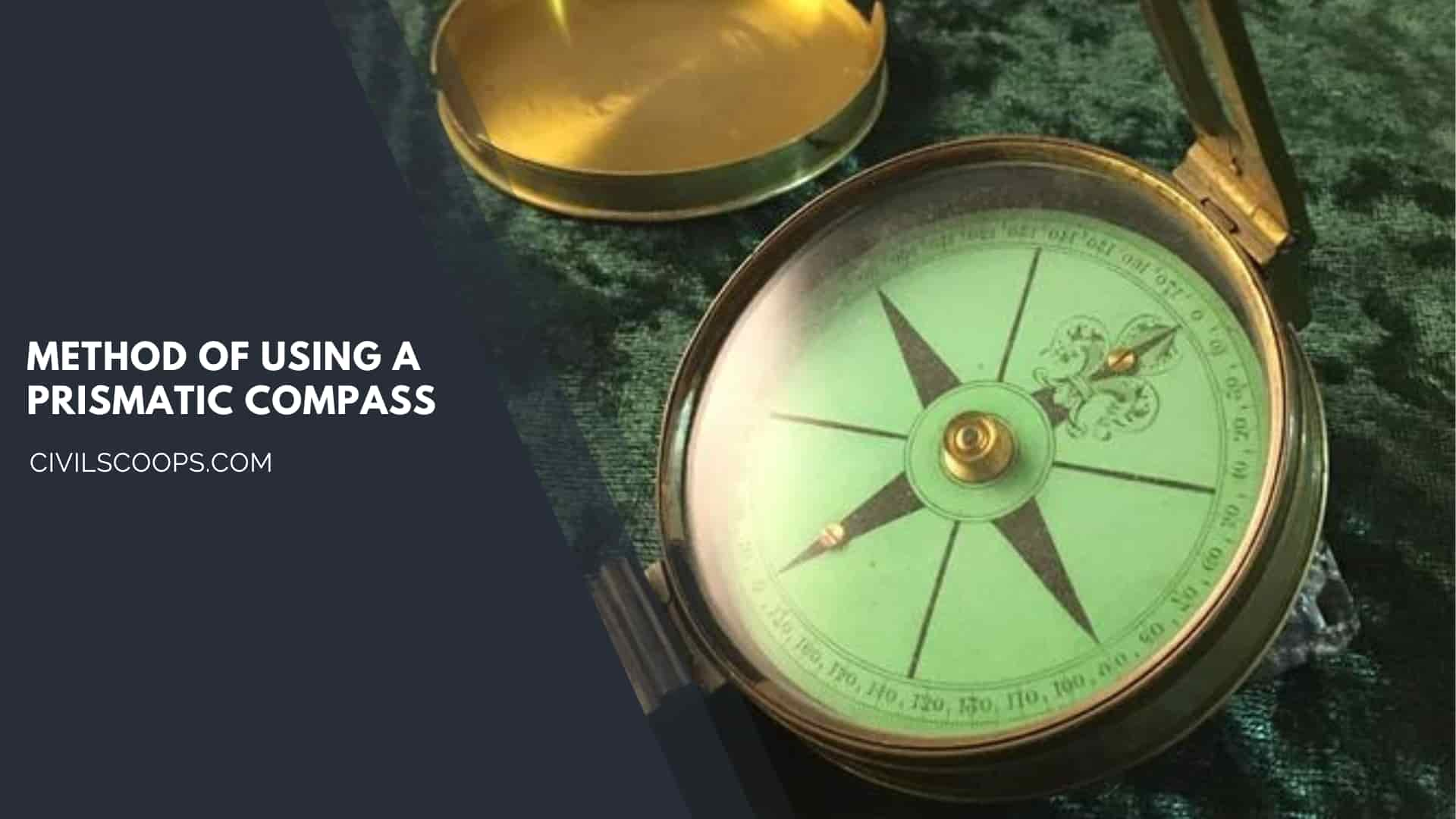
Following tools, including understanding the prismatic compass parts name, are essential for leading a prismatic compass survey.
The radiation method of prismatic compass survey is one of the techniques employed.
- Prismatic compass with tripod stand.
- Arrows.
- Field Book.
- Ranging Rods.
- Measuring Tape.
- Plumbing Fork.
The provisional modifications typically monitored for prismatic compass are:
- Centering.
- Leveling.
- Focusing Prism.
1. Centering
- In centering, the compass must be secure to the stand then usually finished the station.
- To the center, the compass poles of the tripod stand must be progressed inner-outer or in the perimeter way.
- To check centering aligned may be used a pebble from the center of the compass.
2. Levelling
- In prismatic compass, surveying perfects the leveling is not essential nonetheless it must be satisfactory to document allowed interruption of the magnetic needle.
- Afterward centering bubble must be guaranteed in the central of the circle providing for it in the level.
3. Focusing the prism
- In the prismatic compass to focus the prism on the graduated circle, it’s extra is slid up and down till the reading are obviously noticeable.
Prismatic Compass Survey Is Accepted on in Two Methods:
In the context of difference between prismatic compass and surveyor compass, a traverse is a sequence of linked lines whose measurements and directions are to be measured.
The cdiagram of prismatic compass often aids in understanding this better
1. Open Traverse Survey.
A traverse is supposed to be an open traverse once the traverse starts at one point and dismisses at a different point.
Open traverse is also named as unclosed traverse. It is appropriate for surveying roads, coastal lines, etc.
2. Closed Traverse Survey.
A traverse is supposed to be a closed traverse once the traverse designed as a closed circuit.
In this circumstance, together with starting then dismissing points of the traverse accord with each other.
It is appropriate for the survey of limitations of ponds, sports grounds, forests, etc.
Methods of Prismatic Compass Survey
Like the Plane table survey, following methods are used for conducting the prismatic compass survey:
- Radiation or Radial Line Method.
- Intersection or Sketch Method.
- Traverse (Open and Closed) Method.
- Resection Method.
In the circumstance of compass traversing, together with linear in addition, angular dimensions of traverse lines are occupied by means of chain besides prismatic compass correspondingly.
Mutually for bearing and back bearings are measured and essential alterations for local attraction are practical.
If any closing error is attained through the plotting of traverse, then the Bowditch rule is useful for the alteration of error.
Principle of Compass Surveying
Traversing that includes a sequence of linked lines the magnetic bearing of the lines are measured by a prismatic compass then the distance of the area measured by a chain.
Such a survey ensures not need the preparation of a system of triangles.
Working of the Prismatic Compass
- When the compass prismatic needle is freely suspended, it still points to the north, showcasing the prismatic compass definition in action.
- Thus, all angles determined with a prismatic compass are with respect to the north (magnetic meridian).
- The horizontal angle of the line of a survey with relation to the magnetic meridian in the clockwise direction is called the bearing of the line.
- Usually, when using a compass, it is fixed on a light tripod that has a vertical spindle in the ball and socket configuration on which the compass is screwed.
Prismatic Compass Surveying
A prismatic compass is a navigation and surveying instrument which is extensively used to find out the bearing of the traversing and included angles between them, waypoints (an endpoint of the lcourse) and direction.
Compass Surveying
Compass surveying is a type of surveying in which the directions of surveying lines are determined with a magnetic compass, and the length of the surveying lines are measured with a tape or chain or laser range finder.
What Is Prismatic Compass?
A prismatic compass is a navigation and surveying instrument which is extensively used to find out the bearing of the traversing and included angles between them, waypoints and direction.
How to Use a Prismatic Compass?
You may use a prismatic compass in two ways: either by holding it in your hand or mounting it on a tripod. The ability to see and read the compass at the same time is one of its primary benefits.
Uses of Prismatic Compass
Prismatic compasses are used for:
- Land navigation
- Surveying
- Military operations
- Geological surveys
- Forestry and environmental studies
How to Use Compass in Surveying?
The surveyor’s compass is an instrument for determining the horizontal direction of a line with reference to the direction of a magnetic needle. The needle is balanced at its center on a “pivot” so that it swings freely in a horizontal plane.
Methods of Prismatic Compass Survey
In the case of compass traversing, both linear and angular measurements of traverse lines are taken by using chain and prismatic compass respectively. Both fore bearing and back bearings are measured and required corrections for local attraction are applied.
Prismatic Compass Survey Procedure
The Principle of Compass Survey is Traversing; which involves a series of connected lines the magnetic bearing of the lines are measured by prismatic compass and the distance (lengths) of the area measured by chain. Such survey does not require the formulation of a network of triangle.
Types of Prismatic Compass
Type of prismatic compass
Prismatic compass or Lensatic compass
A prismatic compass has a glass prism or a lens and a lid with a hairline. This type of compass often has a magnifying lens for map reading, some sort of light for low light conditions, and a ruler. It is often used for military purposes or plotting.
Surveying Compass and Prismatic Compass
The surveyor’s compass is usually the larger and more accurate instrument, and is generally used on a stand or tripod. The prismatic compass is often a small instrument which is held in the hand for observing, and is therefore employed for less accurate work.
Like this post? Share it with your friends!
Suggested Read –